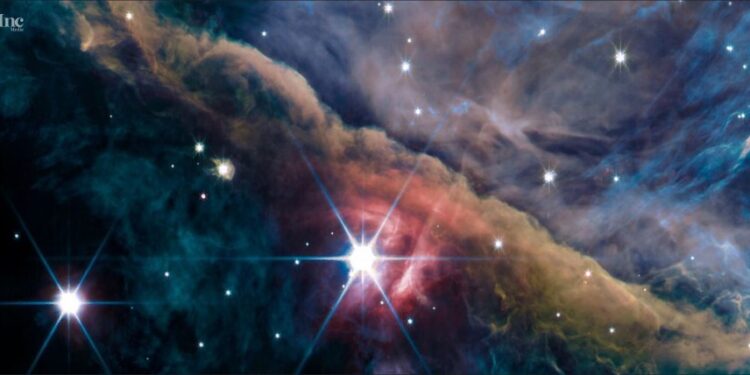The James Webb Space Telescope is capturing the stunning images of the space. Recently, the Webb Telescope captured a stunning photograph of a massive star taking birth in the Milky Way galaxy. It is the first time we are witnessing the new Sun being born. The new start production is taking place in the massive cluster.
Formation of the new start is a complex process. Scientists have named the start formation N79. It is located in the large magellanic cloud.
Telescope using the mid-infrarRed camera captures pictures of the nebula spanning in the vast region of the galaxy consisting of the ionized interstellar atomic hydrogen. The cloud spans approximately 1630 lightyears in length.
The image captured by the telescope is focused on the three giant molecular clauses. Within the cloud, N79 is located in the southernmost region.
Observation shows that the surrounding area is luminous and has a distinct starburst pattern. Various diffraction spikes have been identified by the James Webb Telescope utilizing the giant mirrors to collect the light.
Patterns in the images are emerging due to the shape of the hexagonal symmetry mirrors used in the Webbs 18 primary mirror. Intensely bright and compact objects can be quickly identified using the giant mirrors.
The telescope capturing the longer wavelengths of light using the MIRI produces an extraordinary view of the N79 gas cloud and dust. The telescope is able to penetrate the cloud, blocking the view deeper. Stunning pictures of the hidden newborn stars are amazing.
In contrast, the shorter wavelengths of light are absorbed or scattered, making it challenging to capture them into the sensors in the telescope. Mid-infrared perspective has also revealed most details of the protostars taking birth in the Nebula.
Astronomers looking into the discovery are more interested in understanding the N79 because the region is active and producing new starts. The chemical makeup mirrors the stunning view of the new star formation. The telescope has captured the rare events.
The event is unique because the scientist has never seen such star formation in our Milky Wys. The N79 has shown a different chemical composition, which has opened a new window to the past.
The James Webb Space Telescope has enabled astronomers to learn more about the early star formation process. Such rare events help scientists understand how the universe’s shapes and chemicals form in the dust clouds that eventually become denser.
Then gravity takes over when the denser cloud becomes hot enough to turn into a gas giant. This is how the newborn starts to take place in the space.
Since the inception of the James Webb Telescope, It has released several pictures that make scientists think twice about our existence. The observations of the more extensive web program are to study the early evolution happening in our universe.
Understand space reality and uncover the hidden information by looking at the different wavelengths of the light form captured in the camera.
During the formation of the stars, it goes through various masses and evolutionary stages. Webb’s unparalleled sensitivity helps scientists look beyond the human eye and detect the planets, stars and giant dust clouds roaming our universe.
These gas clouds are the primary building blocks of the stars. Lots are happening in the gas clouds. Observing the details of the cloud and its chemical structures gives you enough data to know why and how the star system evolves in our universe.
New data have helped us to improve our understanding of the cosmos. Webb has improved our knowledge about the origins of the stars. We now know better about the planetary systems. Their formation was unknown before the Webb telescope. Still, now, observing the stars in the other galaxies and their formation patterns, we can picture the past process of the planetary system in our orbit.
Humankind has come a long way since we launched the first satellite into the Earth’s orbit. All these decades of research have helped us understand our origin. We have found several Earth-like Earth planets in other galaxies. All the data will be helpful in future space missions.















 The Inc Media is one of the most renowned global Online Business Magazines, that carries news stories about entrepreneurship, small business management, and business. Being a global business magazine, we carve for influential stories and try to take them globally to uplift the business standards and educate the people about new innovations in the business world...
The Inc Media is one of the most renowned global Online Business Magazines, that carries news stories about entrepreneurship, small business management, and business. Being a global business magazine, we carve for influential stories and try to take them globally to uplift the business standards and educate the people about new innovations in the business world...